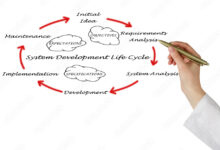System Development: 7 Powerful Steps to Master the Process
Ever wondered how complex software systems come to life? From banking platforms to smart home apps, system development is the engine behind them all. It’s not just coding—it’s strategy, planning, and precision working in harmony.
What Is System Development and Why It Matters

System development refers to the structured process of creating, designing, testing, and deploying information systems that meet specific user or business needs. It’s more than just writing code—it’s a lifecycle that involves analysis, design, implementation, and ongoing maintenance. Whether it’s a mobile app, enterprise resource planning (ERP) system, or an AI-driven analytics tool, system development ensures that technology aligns with real-world demands.
The Evolution of System Development
System development has evolved dramatically since the early days of computing. In the 1960s and 70s, development was largely ad hoc, with programmers writing code without formal methodologies. As software systems grew in complexity, the need for structured approaches became evident.
The introduction of the Waterfall model in the 1970s marked the first major shift toward systematic development. This linear, phase-based approach brought discipline but lacked flexibility. Over time, new models emerged—like iterative development, Rapid Application Development (RAD), and eventually Agile and DevOps—each responding to the limitations of its predecessors.
- 1960s–70s: Ad hoc programming and batch processing systems
- 1980s: Rise of structured programming and the Waterfall model
- 1990s: Emergence of object-oriented design and prototyping
- 2000s: Agile revolution with Scrum and Extreme Programming (XP)
- 2010s–present: DevOps, CI/CD, and cloud-native development
Today, system development is faster, more collaborative, and more user-centric than ever before. The shift from monolithic architectures to microservices and serverless computing reflects how deeply the field has transformed.
Key Components of a Development System
A successful system development project relies on several core components working together seamlessly:
- Hardware: The physical infrastructure—servers, workstations, mobile devices—that runs the system.
- Software: The actual programs, applications, and operating systems that perform tasks.
- Data: The information processed, stored, and retrieved by the system. Data architecture is critical for performance and scalability.
- Procedures: The documented processes and workflows that guide system use and maintenance.
- People: Developers, analysts, testers, project managers, and end-users—all play vital roles.
- Network: Connectivity that enables communication between system components, especially in distributed environments.
These components form the foundation of any system, and neglecting any one can lead to failure. For example, even the most elegant software will underperform on outdated hardware or poorly configured networks.
“The best systems aren’t built—they’re evolved through continuous feedback and iteration.” — Mary Shaw, Software Engineering Pioneer
The System Development Life Cycle (SDLC) Explained
The System Development Life Cycle (SDLC) is the cornerstone framework for managing the creation of software systems. It provides a structured sequence of phases that guide teams from initial concept to deployment and beyond. SDLC ensures quality, reduces risks, and improves predictability in system development.
Phases of the SDLC
The traditional SDLC consists of six primary phases, each with specific goals and deliverables:
Planning: Define project scope, objectives, budget, and timeline.Identify stakeholders and gather high-level requirements.Analysis: Conduct detailed requirement gathering.Use techniques like interviews, surveys, and use case modeling to understand user needs.Design: Create system architecture, data models, UI/UX designs, and technical specifications.This phase answers “how” the system will work.Implementation (Coding): Developers write code based on design documents.
.This is where the system starts taking shape.Testing: Rigorous testing ensures the system meets requirements and is free of critical bugs.Includes unit, integration, system, and user acceptance testing (UAT).Maintenance: Post-deployment support, bug fixes, updates, and enhancements to keep the system relevant and functional.Each phase typically requires sign-off before moving to the next, ensuring accountability and alignment with goals.However, rigid adherence can slow innovation—hence the rise of iterative models..
Benefits of Following SDLC
Adopting a formal SDLC offers numerous advantages:
- Improved Project Control: Clear milestones and deliverables make it easier to track progress and manage resources.
- Risk Reduction: Early identification of issues during analysis and design prevents costly fixes later.
- Better Quality: Structured testing and documentation lead to more reliable and maintainable systems.
- Stakeholder Alignment: Regular reviews ensure that business needs are continuously validated.
- Regulatory Compliance: In industries like healthcare and finance, SDLC helps meet legal and audit requirements (e.g., HIPAA, GDPR).
According to the Standish Group’s CHAOS Report, projects that follow disciplined development processes have a significantly higher success rate than those that don’t.
Popular System Development Methodologies
Choosing the right methodology is crucial for the success of any system development initiative. Different approaches suit different project types, team sizes, and business environments. Let’s explore the most widely used ones.
Waterfall Model: The Classic Approach
The Waterfall model is one of the earliest and most straightforward system development methodologies. It follows a linear, sequential flow where each phase must be completed before the next begins.
It works well for projects with clearly defined requirements and minimal expected changes. For example, government systems or safety-critical applications (like aviation software) often use Waterfall due to its emphasis on documentation and compliance.
However, its rigidity is a major drawback. Once a phase is completed, going back is difficult and expensive. This makes it unsuitable for dynamic environments where user feedback or market conditions change rapidly.
- Pros: Simple to understand, clear milestones, strong documentation
- Cons: Inflexible, late testing, high risk of misalignment with user needs
Despite its limitations, Waterfall remains relevant in regulated industries and large-scale infrastructure projects.
Agile: The Game Changer in System Development
Agile methodology revolutionized system development by prioritizing flexibility, collaboration, and customer feedback. Introduced in 2001 with the Agile Manifesto, it emphasizes individuals and interactions over processes and tools, working software over comprehensive documentation, customer collaboration over contract negotiation, and responding to change over following a plan.
Agile breaks projects into small, manageable iterations called sprints—typically lasting 2 to 4 weeks. At the end of each sprint, a potentially shippable product increment is delivered, allowing stakeholders to review progress and adjust priorities.
Popular Agile frameworks include:
- Scrum: Uses defined roles (Scrum Master, Product Owner, Development Team), sprint planning, daily stand-ups, and retrospectives.
- Kanban: Focuses on visualizing work (via Kanban boards), limiting work in progress (WIP), and continuous delivery.
- Extreme Programming (XP): Emphasizes technical excellence through practices like test-driven development (TDD), pair programming, and continuous integration.
Agile is ideal for startups, product companies, and any environment where requirements evolve. It fosters faster time-to-market and higher customer satisfaction.
“Agile is not a methodology. It’s a mindset.” — Ken Schwaber, Co-Creator of Scrum
DevOps: Bridging Development and Operations
DevOps extends Agile principles by integrating development (Dev) and operations (Ops) into a unified workflow. Its goal is to shorten the system development lifecycle and deliver high-quality software continuously.
Key DevOps practices include:
- Continuous Integration (CI): Developers frequently merge code changes into a shared repository, where automated builds and tests are run.
- Continuous Delivery/Deployment (CD): Code changes are automatically tested and deployed to production or staging environments.
- Infrastructure as Code (IaC): Managing infrastructure through code (e.g., using Terraform or Ansible) instead of manual processes.
- Monitoring and Logging: Real-time insights into system performance and user behavior.
Tools like Jenkins, Docker, Kubernetes, and GitLab CI/CD have made DevOps accessible and scalable. According to Puppet’s State of DevOps Report, high-performing DevOps teams deploy code up to 208 times more frequently than low performers, with 106 times faster recovery from failures.
Requirements Gathering: The Foundation of System Development
No system can succeed without a solid understanding of what it’s supposed to do. Requirements gathering is the process of collecting, analyzing, and documenting the functional and non-functional needs of stakeholders. It’s the bedrock of effective system development.
Functional vs. Non-Functional Requirements
Requirements are typically divided into two categories:
- Functional Requirements: Describe what the system should do. Examples include user authentication, data processing, report generation, and transaction handling.
- Non-Functional Requirements: Define how the system should perform. These include scalability, reliability, security, usability, and response time.
While functional requirements get most of the attention, non-functional ones are equally critical. A system might work perfectly in testing but fail in production due to poor performance under load or inadequate security measures.
For example, an e-commerce platform must not only allow users to add items to a cart (functional) but also handle thousands of concurrent users without crashing (non-functional).
Techniques for Effective Requirement Collection
Successful requirement gathering involves a mix of techniques tailored to the project and stakeholders:
- Interviews: One-on-one or group discussions with key users and decision-makers to uncover needs and pain points.
- Surveys and Questionnaires: Useful for collecting input from a large user base.
- Workshops (JAD Sessions): Joint Application Development workshops bring stakeholders and developers together for collaborative requirement definition.
- Observation: Watching users perform tasks in their natural environment to identify unspoken needs.
- Prototyping: Building early mockups or wireframes to visualize functionality and gather feedback.
- Use Cases and User Stories: Describing system interactions from the user’s perspective. In Agile, user stories follow the format: “As a [user], I want [feature] so that [benefit].”
Tools like Jira, Confluence, and Trello help organize and track requirements throughout the system development lifecycle.
“The most dangerous phrase in system development is: ‘That’s what the user asked for.'” — Often attributed to usability expert Jakob Nielsen
System Design: Turning Requirements into Architecture
Once requirements are clear, the next step is system design—the blueprint phase where technical decisions shape the final product. This stage determines how the system will be structured, how components interact, and how data flows through the system.
High-Level vs. Low-Level Design
System design is typically divided into two levels:
- High-Level Design (HLD): Also known as architectural design, this defines the overall system structure. It includes module breakdown, technology stack selection, database design, and integration points. HLD answers questions like: Will it be a monolith or microservices? Which database (SQL or NoSQL)? How will authentication be handled?
- Low-Level Design (LLD): Focuses on detailed specifications for each module. This includes class diagrams, database schemas, API contracts, and algorithm logic. LLD is used by developers during coding.
A well-thought-out HLD prevents technical debt and scalability issues down the line. For example, choosing a scalable cloud architecture early can save millions in rework later.
Design Patterns and Best Practices
Experienced architects use proven design patterns to solve common problems:
- MVC (Model-View-Controller): Separates data (Model), user interface (View), and business logic (Controller). Widely used in web applications.
- Singleton: Ensures a class has only one instance and provides global access to it—useful for database connections.
- Observer: Defines a one-to-many dependency between objects so that when one changes, others are notified automatically—ideal for event-driven systems.
- Factory Method: Creates objects without specifying the exact class, promoting flexibility and decoupling.
Following best practices like loose coupling, high cohesion, and separation of concerns leads to systems that are easier to maintain, test, and extend.
Coding and Implementation: Bringing the System to Life
This is where the rubber meets the road. Coding transforms design documents into executable software. While often seen as the core of system development, it’s just one piece of a much larger puzzle.
Choosing the Right Programming Language and Tools
The choice of programming language depends on the system’s purpose, performance needs, and ecosystem:
- Python: Great for data analysis, AI, and rapid prototyping due to its simplicity and rich libraries.
- Java: Widely used in enterprise applications, Android apps, and large-scale systems.
- JavaScript (Node.js): Dominates web development, especially for full-stack and real-time applications.
- C#: Preferred for Windows applications and .NET ecosystem.
- Go or Rust: Ideal for high-performance, concurrent systems like cloud services.
Integrated Development Environments (IDEs) like Visual Studio Code, IntelliJ IDEA, and Eclipse boost productivity with features like code completion, debugging, and version control integration.
Code Quality and Best Practices
Writing clean, maintainable code is essential for long-term success. Key practices include:
- Code Reviews: Peer reviews catch bugs early and improve code quality.
- Version Control: Using Git to track changes, collaborate, and manage branches.
- Documentation: Inline comments and external docs help future developers understand the code.
- Testing: Writing unit and integration tests to ensure reliability.
- Refactoring: Improving code structure without changing behavior to reduce technical debt.
Tools like SonarQube, ESLint, and Pylint help enforce coding standards and detect issues automatically.
Testing and Quality Assurance in System Development
No system is complete without rigorous testing. Quality assurance (QA) ensures that the software meets requirements, performs well, and is free of critical defects.
Types of Testing in the SDLC
Different testing types serve different purposes:
- Unit Testing: Tests individual components or functions. Often automated using frameworks like JUnit (Java) or PyTest (Python).
- Integration Testing: Verifies that modules work together as expected.
- System Testing: Evaluates the complete system against requirements.
- User Acceptance Testing (UAT): Conducted by end-users to confirm the system meets their needs.
- Performance Testing: Assesses speed, scalability, and stability under load.
- Security Testing: Identifies vulnerabilities like SQL injection, XSS, and authentication flaws.
Automated testing is a cornerstone of modern system development, enabling faster feedback and continuous integration.
The Role of QA Teams
QA teams are not just testers—they’re quality advocates. They work closely with developers, product managers, and stakeholders to define test strategies, create test cases, and report defects. Their goal is to prevent bugs from reaching production.
In Agile and DevOps environments, QA is embedded throughout the lifecycle, not just at the end. This shift-left approach improves efficiency and reduces rework.
“Testing shows the presence, not the absence of bugs.” — Edsger W. Dijkstra, Computer Science Pioneer
Deployment and Maintenance: The Final Phases of System Development
Deployment marks the transition from development to production. But the system development journey doesn’t end there—maintenance ensures the system remains valuable over time.
Deployment Strategies
How you deploy your system can impact user experience and risk:
- Big Bang Deployment: The entire system goes live at once. High risk but simple to manage.
- Phased Deployment: Roll out features incrementally. Reduces risk and allows for feedback.
- Blue-Green Deployment: Two identical environments; traffic is switched from old (blue) to new (green) after testing. Minimizes downtime.
- Canary Release: Release to a small subset of users first, then gradually expand. Ideal for large-scale systems.
CI/CD pipelines automate deployment, reducing human error and speeding up releases.
Ongoing Maintenance and Support
Maintenance is often underestimated but consumes up to 70% of a system’s total cost over its lifetime. It includes:
- Corrective Maintenance: Fixing bugs and issues reported by users.
- Adaptive Maintenance: Updating the system to work with new environments (e.g., new OS, browsers).
- Perfective Maintenance: Enhancing features based on user feedback.
- Preventive Maintenance: Optimizing performance and addressing potential issues before they occur.
Regular updates, security patches, and performance tuning keep the system secure and efficient.
Emerging Trends Shaping the Future of System Development
The field of system development is constantly evolving. New technologies and practices are redefining how we build software.
Artificial Intelligence and Machine Learning Integration
AI is no longer a futuristic concept—it’s embedded in system development. From automated code generation (GitHub Copilot) to intelligent testing tools, AI is boosting productivity.
ML models are being integrated into applications for predictive analytics, natural language processing, and personalization. Developers now need to understand data pipelines, model training, and ethical AI considerations.
Low-Code and No-Code Platforms
Platforms like OutSystems, Mendix, and Microsoft Power Apps allow non-developers to build applications using visual interfaces. While not suitable for complex systems, they accelerate prototyping and democratize development.
These tools are reshaping the role of professional developers, who now focus more on integration, security, and complex logic.
Cloud-Native and Serverless Architectures
Cloud computing has transformed system development. Cloud-native applications are designed specifically for cloud environments, leveraging containers, microservices, and managed services.
Serverless computing (e.g., AWS Lambda, Azure Functions) lets developers run code without managing servers, reducing operational overhead and scaling automatically.
According to Gartner, over 95% of new digital workloads will be deployed on cloud-native platforms by 2025.
What is system development?
System development is the process of creating, designing, testing, and deploying software systems to meet specific user or business needs. It involves multiple phases, including planning, analysis, design, implementation, testing, and maintenance.
What are the main SDLC models?
The main system development life cycle (SDLC) models include Waterfall, Agile, Iterative, Spiral, and DevOps. Each has its strengths and is suited to different types of projects.
How does Agile improve system development?
Agile improves system development by promoting iterative delivery, continuous feedback, collaboration, and adaptability to change. It leads to faster time-to-market and higher customer satisfaction.
Why is testing important in system development?
Testing ensures that the system meets requirements, performs reliably, and is free of critical defects. It reduces risks, improves quality, and prevents costly failures in production.
What skills are needed for system development?
Key skills include programming, problem-solving, system design, database management, version control, testing, and collaboration. Familiarity with methodologies like Agile and tools like Git, Docker, and CI/CD platforms is also essential.
System development is a dynamic and multifaceted discipline that sits at the heart of modern technology. From defining requirements to maintaining live systems, every phase plays a critical role in delivering value. Whether you’re using traditional Waterfall or cutting-edge DevOps, the principles of clarity, collaboration, and continuous improvement remain constant. As AI, cloud computing, and low-code platforms reshape the landscape, the future of system development promises even greater speed, accessibility, and innovation. The key to success lies in choosing the right approach, tools, and mindset for your unique challenges.
Further Reading:









